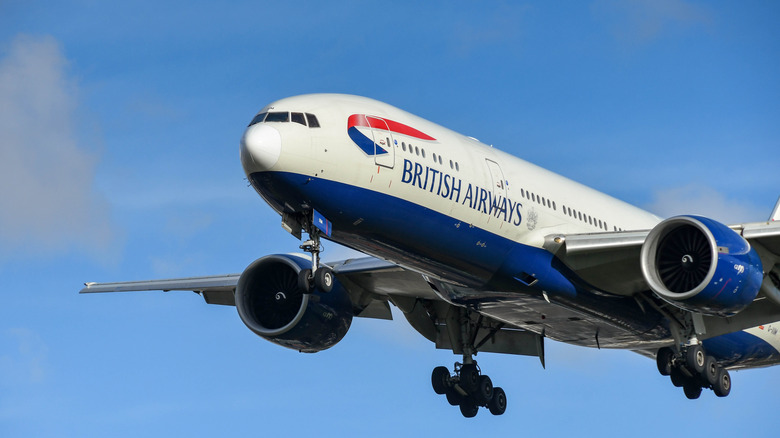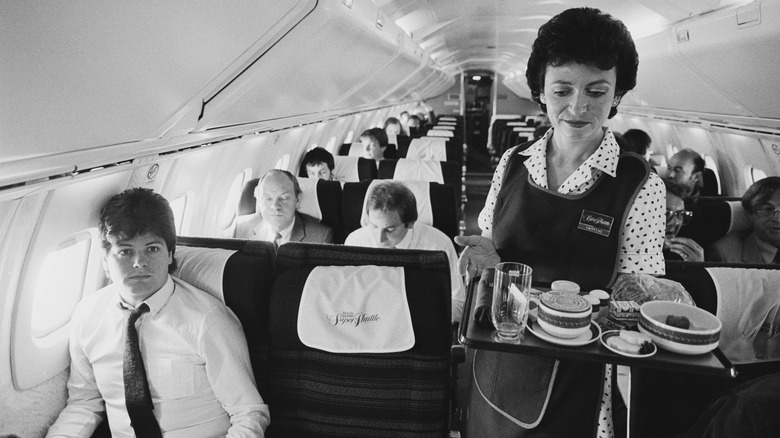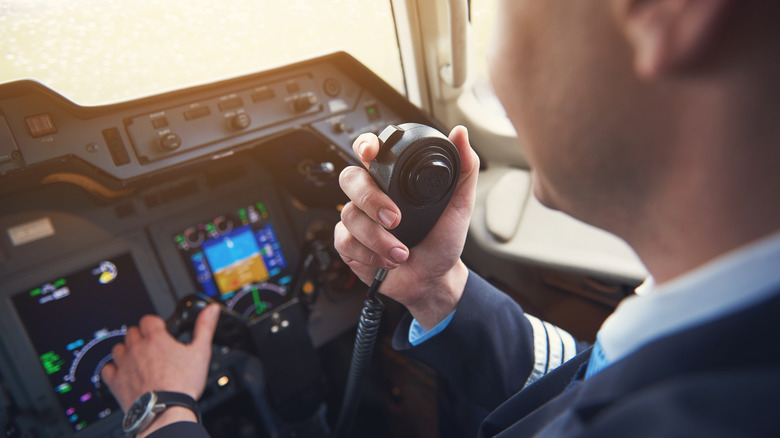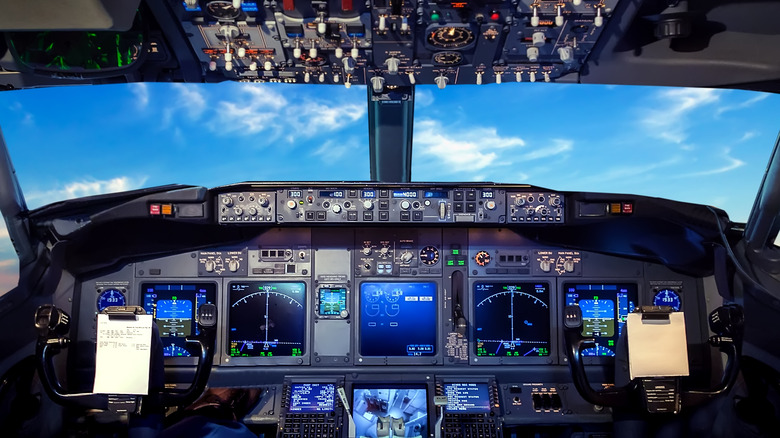The True Story Of The Pilot Sucked Out Of A Plane At 17,000 Feet Who Survived
If you've flown on an airplane, you've almost certainly heard the pilot overhead, saying from the cockpit: "This is your captain speaking. We've run into some unexpected turbulence, so please return to your seats" — or something to that effect. The captain's job is to drive the plane safely, carrying its passengers from one destination to the next. But on one flight in the U.K. in 1990, it was the captain who was in trouble.
Last year, images surfaced of a pilot falling out of a plane's cockpit window, and the memes quickly went viral. Internet users compared the man bursting from the plane to 2020, with another image of a copilot holding a man's ankles for dear life labeled as 2021, per Snopes. These days, it's not always clear which photos and information on the internet are real and which are misinformation. Although some of the memed-out photos of the pilot falling out of a plane circulating were fake, the story behind them is miraculously true (per NZ Herald).
Flight 528 from the U.K. to Spain
On June 10, 1990, a British Airways flight took off around 7 a.m. from the U.K. to Málaga, Spain, according to the Aviation Safety Network. On board were 81 passengers and 6 crew members, including the plane's captain Tim Lancaster, per an official report by the U.K. Department of Transport.
Once the plane had stabilized in the air to about 17,300 feet pressure altitude, the captain and co-pilot released their shoulder harnesses and loosened their seatbelts to get comfortable (via Snopes). Then, something like out of a movie or the television show "Lost" — that would literally go on to become the subject of a documentary — occurred about a half-hour after the flight's departure just as it was passing over Dicot in Oxfordshire.
Right when the crew began to serve drinks in the cabin, an explosion occurred and the fuselage filled with mist (via Aviation Safety Network). As a result, the flight was depressurized and the cockpit's left window screen was suddenly blown out. Lancaster was sucked out of the opening into air temperatures of just over 1 degree Fahrenheit and extreme winds (per U.K. Department of Transport, Snopes).
Mayday mayday
In a stroke of luck, one of the stewards was working on the cabin side door where the captain was and rushed to his aid, holding onto his waist to prevent him from fully being sucked out of the aircraft. The other flight attendants made an announcement on the overhead to alert the passengers and went into their emergency positions, per the U.K. Department of Transport.
Meanwhile, the co-pilot called "Mayday" into the air traffic radar control service and began his descent to safety, putting the plane into autopilot so he could assist the stewards. However, the "Mayday" was the only information that went through and the chief sector controller took no further action, waiting for more information about the emergency (via the U.K. Department of Transport). Luckily there was no traffic in the way to cause more havoc to the chaos. According to Snopes, the co-pilot eventually made contact with the safety team on the ground telling them the captain was "half sucked out" of the airplane and that "I believe he is dead."
Flight attendants to the rescue
Meanwhile, other flight attendants hooked arms to prevent them from falling out themselves and assisted the first flight attendant in holding on to the captain. Because the air pressure was so strong, they couldn't pull him back in the airplane and began losing strength to hold on, according to the Aviation Safety Network.
Nigel Ogden was one of those flight attendants. According to The Telegraph, he said he first thought he'd heard a bomb when the pressure caused the explosion. He said, "I whipped around and saw that the front windscreen had disappeared, and Tim was going out through it," he said. "He had been sucked out of his seatbelt –- and all I could see were his legs. His shirt had been pulled off his back, and his body was bent upwards, doubled over around the top of the aircraft. I jumped over the control column and grabbed him around the waist – to avoid him going out completely."
Other flight attendants began to rotate in, maintaining a hold on the captain's ankles. Lancaster would later say in the documentary released about the incident that he had tried to turn his torso towards the body of the plane to better be able to breathe against the raging winds. However, he quickly lost consciousness and doesn't remember the traumatic events that followed (via Snopes).
The cause of the incident
Luckily, the flight attendants were able to maintain their grip until the plane could safely land at Southampton Airport at 7:55 a.m., per the U.K. Department of Transport. According to The New York Times, bloodstains and pieces of clothing were left in and outside of the cockpit. Once on the ground, Lancaster was rushed to Southampton General Hospital, where he was treated for bone fractures in his arms and frostbite from his exposure to the high altitude (via U.K. Department of Transport).
According to the Aviation Safety Network, the left windscreen was replaced just 27 hours before the flight. However, the person who installed it used bolts that were too small for the size of this airplane's windscreens, causing it to easily slip out with depressurization. Per the U.K. Department of Transport, this process was due to a conglomeration of "poor work practices, poor judgments and perceptual errors, each one of which eroded the factors of safety built into the method of operation promulgated by British Airways." Specifically, they attributed the errors to "sleep deprivation and circadian effects associated with the end of a first night shift."
Of course, the responsibility fell on more people than just the one maintenance person who secured the bolts. This was supposed to be checked by a shift maintenance manager, but the incorrect installation all went "unnoticed or unheeded," per the U.K. Department of Transport.
'The tingle down the spine'
After Lancaster was released from the hospital, he returned to flying just five months later. He even stayed with the same airline until moving to fly with easyJet in 2003 and ultimately retiring in 2008 (via The Telegraph).
"It's one of these things that you see in films, that happens in films, but it doesn't happen in real life," he said, per Snopes. "The hairs on the back of the neck go up and there's this feeling down the spine, the tingle down the spine and you think, 'No, it's not for real,' but it's got to be."
After careful inspection of the incident, the airline issued eight new safety recommendations to change their practices and prevent an accident like this from happening again, per the U.K. Department of Transport. As for the flight attendants, they were recognized for their heroic acts by Queen Elizabeth II in 1991 for Valuable Services in the Air despite being in danger themselves (via London Gazette).





